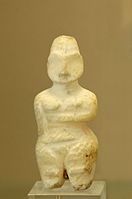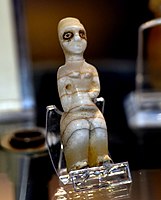 | |
| Location | Saladin Province, Iraq |
|---|---|
| Coordinates | 34°07′16″N 43°54′18″E / 34.12111°N 43.90500°E / 34.12111; 43.90500 |
| Type | settlement |
| History | |
| Founded | 5th millennium BC |
| Periods | Ubaid, Hassuna, and Samarra culture |
| Site notes | |
| Excavation dates | 1964-1971 |
| Archaeologists | Behnam Abu Al-Soof. Khalid Ahmad Al-a'dami, Walid Yasin |
| Condition | Ruined |
| Ownership | Public |
| Public access | Yes |
Tell es-Sawwan is an important Samarran period archaeological site in Saladin Province, Iraq. It is located 110 kilometres (68 mi) north of Baghdad, and south of Samarra. It lies on a 12 meter high cliff overlooking the Tigris River.
The site is a primarily Ubaid, Hassuna, and Samarra culture occupation with some later Babylonian graves. It is considered the type site for the Samarran culture.
History
The inhabitants of Tell es-Sawwan were farmers who used irrigation from the Tigris to support their crops, as rainfall was unreliable. They used stone and flint tools similar to those of the Hassuna culture. Their prosperity, probably based on the dependability of irrigated crops, is evidenced by the presence of fine Samarran ware and beautiful, translucent marble vessels.
Underfloor graves of adults and children contained terracotta and alabaster statuettes of women and men, in various poses; some of these had the eyes and pointed heads typical of the Ubaid period.
Archaeology
Tell es-Sawwan is an oval mound 350 metres (1,150 ft) long by 150 metres (490 ft) wide with a maximum height of 3.5 metres (11 ft). It consists of three tells, labeled A, B, and C aligned from north to south. Some of the western portion of the site has been lost to river erosion. The main mound was surrounded by a three-meter defensive ditch and a strong mudbrick wall. The neolithic village, on mounds B and C, consisted of large mudbrick houses and other buildings thought to be granaries. There were five occupation layers. Among the finds were 77 neolithic clay tokens. A number of clay sling bullets were also found, by a ditch and wall the excavators termed defensive in nature. The ditch was radiocarbon dated to 5730 ± 75 B.C.
Tell es-Sawwan was first noted by Ernst Herzfeld in 1930 while working at Samarra. The site was excavated by a team from the Iraqi Directorate General of Antiquities in seven seasons between 1964 and 1971. The first, third, and fourth seasons were directed by Behnam Abu Al-Soof, the second season by Khalid Ahmad Al-a'dami and the sixth and seventh season by Walid Yasin. Donny George Youkana worked briefly at the site in 1985. In 1988 and 1989 further excavations were conducted by C. Breniquet for the Delegation Archeologique Francaise en IraK.
Gallery
-
 Female figurine from Tell es-Sawwan, Louvre Museum
Female figurine from Tell es-Sawwan, Louvre Museum
-
 Mother goddess from Tell es-Sawwan, Iraq, 6000-5800 BCE. Iraq Museum
Mother goddess from Tell es-Sawwan, Iraq, 6000-5800 BCE. Iraq Museum
-
 Mother goddess figurine from Tell es-Sawwan, Iraq, 6000-5800 BCE. Iraq Museum
Mother goddess figurine from Tell es-Sawwan, Iraq, 6000-5800 BCE. Iraq Museum
-
 Alabaster jar with a necklace from Tell es-Sawwan, Iraq. 6000-5800 BCE. Iraq Museum
Alabaster jar with a necklace from Tell es-Sawwan, Iraq. 6000-5800 BCE. Iraq Museum
-
 Bowl with human bones from Tell es-Sawwan, Iraq, 6000-5800 BCE. Iraq Museum
Bowl with human bones from Tell es-Sawwan, Iraq, 6000-5800 BCE. Iraq Museum
See also
References
- Charles Keith Maisels, "Early Civilizations of the Old World: The Formative Histories of Egypt, The Levant, Mesopotamia, India and China", Routledge, 2001 ISBN 978-0415109765
- Oates, Joan, "The Baked Clay Figurines from Tell Es-Sawwan", Iraq, vol. 28, no. 2, pp. 146–53, 1966
- Helwing, Barbara, "Reconsidering the Neolithic Graveyard at Tell Es-Sawwan, Iraq", Paléorient, vol. 42, no. 1, pp. 123–36, 2016
- Overmann, Karenleigh A., "CHAPTER 9. THE NEOLITHIC CLAY TOKENS", in The Material Origin of Numbers: Insights from the Archaeology of the Ancient Near East, Piscataway, NJ, USA: Gorgias Press, pp. 157-178, 2019
- Roper, Marilyn Keyes, "Evidence of Warfare in the Near East from 10,000-4,300 B.C.", in War, its Causes and Correlates, edited by Martin A. Nettleship and Dale Givens, Berlin, New York: De Gruyter Mouton, pp. 299-344, 1975
- Herzfeld E., "Die Ausgrabungen von Samarra 5. Die vorgeschichtlichen Töpfereien von Samarra", Berlin: Reim, 1930
- F. el-Wailly and B. Abu Al-Soof, "The Excavations at Tell es-Sawwan: First Preliminary Report (1964)", Sumer , vol. 21, pp. 17-32, 1965
- Khalid Ahmad Al-a'dami, "Excavations at Tell es-Sawwan (Second Season)", Sumer, vol. 24, pp. 57-95, 1968
- Ghanim Wahida, "Excavations at Tell es-Sawwan (Third Season) 1966", Sumer, vol. 23, pp. 167-178, 1967
- Behnam Abu Al-souf, "Tell es-Sawwan: Excavation of the Fourth Season (Spring 1967)", Sumer, vol. 24, pp. 3-15, 1968
- Behnam Abu Al-soof, "Tell es-Sawwan: Fifth Seasons Excavations (Winter 1967, 1968)", Sumer, vol. 27, pp. 3-7, 1971
- Walid Yasin, "Excavation at Tell es-Sawwan - the Sixth Season (1969)", Sumer, vol. 26, pp. 3-20, 1970
- Donny George Youkana, "Tell Es-Sawwan: The Architecture of the Sixth Millennium BC", NABU, 1997, ASIN B001AC6TMA ISBN 978-1-897750-05-6
- "Excavations in Iraq 1987-88", Iraq, vol. 51, pp. 249–65, 1989
- "Excavations in Iraq 1989-1990", Iraq, vol. 53, pp. 169–82, 1991
- C. Breniquet, Rapport sur deux campagnes de fouilles à Tell es-Sawwan, 1988–1989, Mesopotamia, vol. 27, pp. 5–30, 1992
Further reading
- Abdul Qadir al-Tekriti, The Flint and Obsidian Implements of Tell es-Sawwan, Sumer, vol. 24, pp. 53–36, 1968
- Catherine Breniquet, "Tell Es-Sawwan: Realites et Problemes", Iraq, vol. 53, pp. 75–90, 1991
- Breniquet, Catherine, "Tell Es-Sawwan, Irak. Essai de Synthèse et de Prospective Sur La Néolithisation de La Plaine Mésopotamienne", Paléorient, vol. 42, no. 1, pp. 137–49, 2016
- Connan, J. and Deschesne, O., "Origine et alteration de quelques bitumes archaeologiques de tell Es-Sawwan (5500-5000 av. J.C.)", Mesopotamia 27, pp. 47–61, 1992
- Connan, J., D. Dessort, and O. Deschesne, "A model of highly weathered oil seepages: the bitumens of Tell Es-Sawwan in Iraq", Bulletin des Centres de Recherches, Exploration-Production Elf-Aquitaine;(France) 16.1, pp. 33–53, 1992
- Coqueugniot, E., "Tell Es-Sawwan (1988-1989): Note concernant les outils de Pierre Taillee", Mesopotamia 27, pp. 31–46, 1991
- Ducos, P., "La faune de Tell Es-Sawwan (1988-1989)", Mesopotamia 27, pp. 63–70, 1992
- Keith Flannery and Jane C. Wheeler, Animal Bones From Tell as-Sawwan Level III (Samaran Period), Sumer, vol. 23, pp. 179–182, 1967
- H Helbaek, Early Hassunan vegetable food at Tell es-Sawwan near Samarra, Sumer, vol. 20, 1966
- Ippolitoni F., "The pottery of Tell es-Sawwan - First season", Mesopotamia V-VI, pp. 105–179, 1970–71
- Joan Oates, The Baked Clay Figurines from Tell es-Sawwan, Iraq, vol. 28, no. 2, pp. 146–153, 1966
- Qaddoori, Waleed Khalid, Badawi Mohamed Ismail, and Mahmoud Abdel Hafez Adam, "Study the Risks Affecting Adobe Buildings in Tell Es-Sawwan, Iraq, and Methods of Restoration and Reinforcement", Al Malweah for Archaeological and Historical studies 7.21, pp. 105–142,2020
- F. Strika, Clay human figurines with applied decoration from Tell Es-Sawwan, Mesopotamia, vol. 33, pp. 7–21, 1998
- Strika, Fiorella Ippolitoni, "W-like signs on pottery, anthropomorphic vessels and on seals: Pre-writing at Tell es-Sawwan", Rivista Degli Studi Orientali, vol. 72, no. 1/4, pp. 1–10, 1998